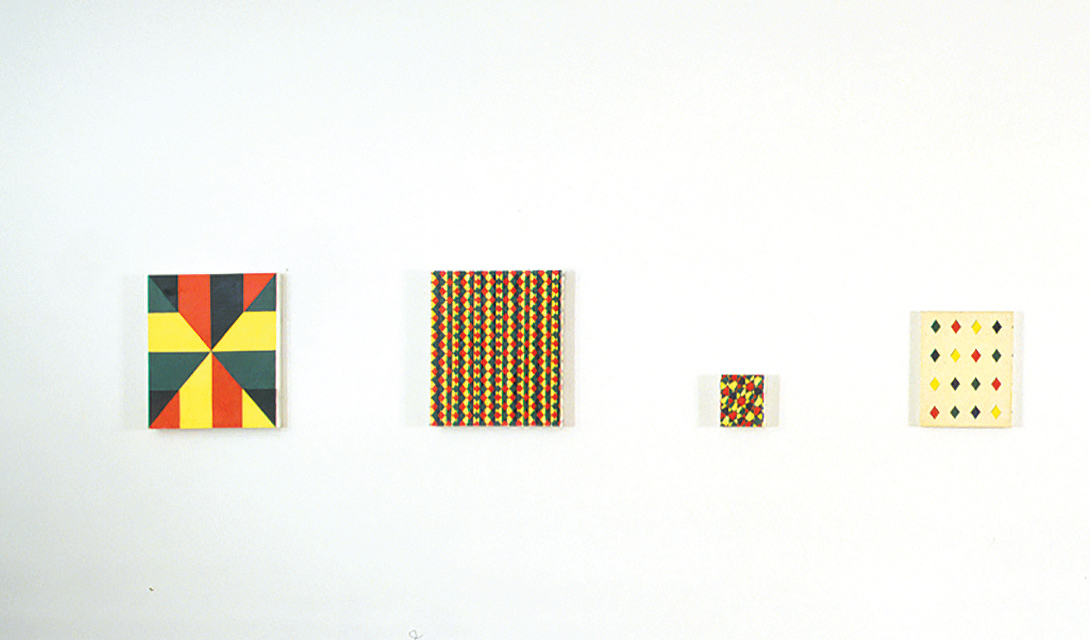


In 1968, the National Gallery of Victoria launched its new building in St Kilda Road with an exhibition of Australian painting inspired by American abstraction, entitled The field. Painters such as Robert Hunter, Robert Rooney and Peter Booth were tackling minimalist abstraction and geometric structures. Kerrie Poliness, with her serial explorations of geometric form and commitment to the languages of modernist abstraction, would have fitted right in.
While the genre of geometric abstraction lives with the constant threat of formal and conceptual parameters deadening the surface, Poliness finds ways to reinvigorate the use of pattern. Her grids leap and buck, alternating between large swathes of colour and tiny, meticulous constructions.
Poliness rose to prominence in the late 1980s amid a group of like-minded artists who created the Store 5 gallery in Melbourne. Store 5 was founded in 1989 by Poliness and Gary Wilson as an independent artist-run space, with a focus on geometric abstraction, which had been sidelined by the more popular expressionist and pop styles of the 1980s.
In stark contrast to the almost stuffy and formal approach to abstraction in the 1960s, Poliness's work is infused with a funky humour and a feminine touch far removed from the blocky harshness of much (male) 1960s abstraction. In Poliness's work the inherited modernist tradition of constructivism meets the new post-modern mentality of cyberpunk. Her nets and grids have more in common with William Gibson's novel Neuromancer (1984) or the film The Matrix (1999) than the dusty history of abstraction. This is decoration as data, feminine patterning with a neon glare.
Following the lead of modernist abstraction, which sought a reductive purity, Poliness limited her palette to red, green and yellow with occasional blacks. But Poliness's rapid-fire production results in a hallucinogenic tsunami of stimuli, which seems more like a high-speed street version of minimalism than the restrained discipline of the modernist grid.
Although there are, of course, exceptions, geometric abstraction has largely been the realm of the heroic male. The infusion of the feminine into this realm in Poliness's work is hinted at in the playful, at times meandering, approach to pattern-making. There is little sense of pretension here. Poliness is creating modernist grid painting for mass consumption. As Carolyn Barnes has noted:
It is Poliness's specific intention to reclaim the meaning of abstraction and make it available for contemporary use ... In the very materiality of her work, the simplicity of its production and its frequent invocation of the decorative, Poliness refuses the inert ideology of 'high art' and the mystification of abstraction as esoteric or hermetic.1
Unlike so much modernist abstraction, with its heroicism hammered home by the likes of American critic Clement Greenberg, Poliness creates works that are viewer friendly. Over the years she has executed seductive wall paintings in the manner of American Sol Le Witt, but unlike his harsh constructions, Poliness’s wall works dance and bounce. To some extent she breaks down the role of artist and viewer, at times encouraging others to assist in the carefully instructed installation of the wall drawings.
For all that Poliness acknowledges the past and feeds from the cool histories of constructivism and modernist abstraction, she does so with a playful irreverence and a cheeky sense of seductive fun.
- Ashley Crawford
Kerrie Poliness is represented in Australia by Anna Schwartz Gallery, Melbourne and Sydney.